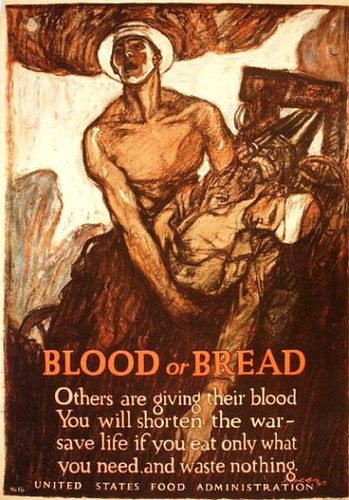
http://www.flickr.com/photos/mfspeccoll/4903407950/in/set-72157624742434...
This poster lacks the vividness as well as a clear picture to any passerby on the street in 1917. Two requirements which were ranked by James Pearl for a successful poster are not in this picture; there is not much color or brightness to motivate people; and it doesn’t have a clear or specific design. Instead the poster has mainly two colors, white and multiple shades of brown, as well as a rough sketch of the two soldiers in the midst of war.
This poster does hit the emotions of many just because it lacks the usual ‘bright/clear design’ of most of the WWI posters. The imagery of a brave soldier holding his wounded comrade in the trench sends a chilling realization of the dark and dreary conditions which these men are living in. The only thing the poster asks, of the American citizens at home, is to ration the food for the soldiers; as well as to not waste any food that the citizens have. This was another method used by the artist behind the making of each poster [they] “should be single, clear, specific and must appeal to the emotions rather than to the intellect.” In my opinion, that is exactly what the poster ‘Blood or Bread’ portrays; eat what you must, send the rest to the soldiers so that they have nutrients to finish the war, and less lives will be taken in the long run.
This poster has many elements which would be tied in with Vera Brittain’s ‘A Testament of Youth’. The most obvious being, the wounded soldier has lost or has been severely injured to the eyes, much like Victor.

Comments
Matt Picht
Mon, 02/04/2013 - 18:37
Permalink
Nice analysis, I think you
Nice analysis, I think you were right to point out how bleak this poster is in comparison to others. "Blood or Bread" is unique as a poster in that it attempts to communicate some of the realities of trench warfare. There is an implicit accusation in communicating these realities to a home front audience; witnessing these grim scenes leaves an audience feeling guilty about their comparatively charmed lives which these soldiers would be fighting to protect. Short term, I expect posters like these garnered plenty of support from the civilian populace; however, as the war dragged on and the home front became inundated with images such as "Blood or Bread", I should think these type of posters would collect only resentment and despair, sapping civilians of their patriotic willingness to sustain the war.